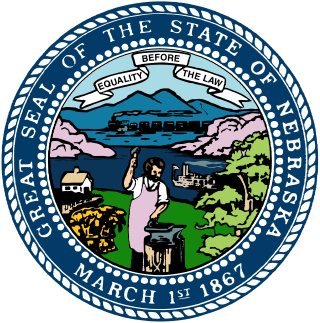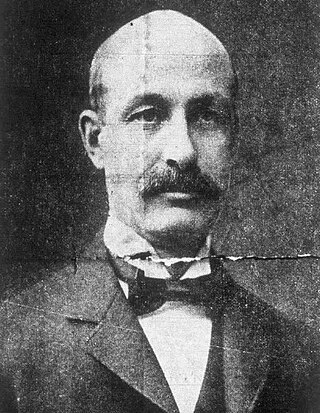
The 1882 South Carolina gubernatorial election was held on November 7, 1882 to select the governor of the state of South Carolina. Hugh Smith Thompson was nominated by the Democrats and ran against J. Hendrix McLane, a Greenback-Labor candidate. Thompson easily won the general election and became the 81st governor of South Carolina.

The 1885 New York state election was held on November 3, 1885, to elect the governor, the lieutenant governor, the secretary state, the state comptroller, the attorney general, the state treasurer and the state engineer, as well as all members of the New York State Assembly and the New York State Senate.

The 1954 Nebraska gubernatorial election was held on November 2, 1954, and featured Mayor of Lincoln Victor E. Anderson, a Republican, defeating Democratic nominee, attorney William Ritchie.

The 1920 Nebraska gubernatorial election was held on November 2, 1920, and featured incumbent Governor Samuel R. McKelvie, a Republican, defeating Democratic nominee, former Governor John H. Morehead, and progressive-backed independent candidate, York Mayor Arthur G. Wray, to win a second and final two-year term in office.

The 1880 Illinois gubernatorial election was held on November 2, 1880.

The 1910 Nebraska gubernatorial election was held on November 8, 1910.

The 1900 Nebraska gubernatorial election was held on November 6, 1900.

The 1898 Nebraska gubernatorial election was held on November 8, 1898. Incumbent Populist Governor Silas A. Holcomb did not stand for re-election. Populist and Democratic fusion nominee William A. Poynter defeated Republican nominee Monroe Hayward with 50.19% of the vote.

The 1882 Nebraska gubernatorial election was held on November 7, 1882. Incumbent Republican governor Albinus Nance did not seek reelection. This election featured James W. Dawes, a Republican, defeating Democratic nominee J. Sterling Morton and Greenback nominee Edward P. Ingersoll.

The 1880 Nebraska gubernatorial election was held on November 2, 1880, in order to elect the Governor of Nebraska. Incumbent Republican Governor of Nebraska Albinus Nance defeated Democratic nominee Thomas Tipton, who had formerly served as a Republican US Senator from Nebraska.

The 1878 Nebraska gubernatorial election was held on November 5, 1878. Incumbent Republican governor Silas Garber did not seek reelection. This election featured Republican nominee Albinus Nance, the Speaker of the Nebraska House of Representatives, defeating Democratic nominee Colonel William H. Webster, a lawyer from Merrick County, Nebraska, and Greenback Party nominee Levi G. Todd, a former member of the Nebraska Territorial House of Representatives from Cass County, Nebraska.

The 1876 Nebraska gubernatorial election was held on November 7, 1876. It was the first election held under the newly adopted Nebraska Constitution of 1875. The election featured incumbent Governor Silas Garber, a Republican, defeating Democratic nominee Paren England, a lawyer from Lancaster County, Nebraska, and Greenback Party nominee Jonathan F. Gardner, former independent candidate for Governor of Nebraska in 1874.

The 1876 Nebraska lieutenant gubernatorial election was held on November 7, 1876, and featured Republican nominee Othman A. Abbott defeating Democratic nominee Miles Zentmeyer and Greenback Party nominee Allen Root.

The 1878 Nebraska lieutenant gubernatorial election was held on November 5, 1878, and featured Republican nominee Edmund C. Carns defeating Greenback and Democratic nominee Theron M. Blakely as well as the original Democratic nominee F. J. Mead who still received some votes. Originally, the Democratic party had nominated F. J. Mead for lieutenant governor. However, in late October 1878, the state central committees of the Democratic and Greenback parties met in Lincoln, Nebraska, and decided to replace F. J. Mead with Greenback candidate Theron M. Blakely on the ticket for lieutenant governor.

The 1882 Nebraska lieutenant gubernatorial election was held on November 7, 1882, and featured Republican nominee Alfred W. Agee defeating Democratic nominee Jesse F. Warner as well as Greenback nominee D. P. Reynolds.

The 1884 Nebraska lieutenant gubernatorial election was held on November 4, 1884, and featured Republican nominee Hibbard H. Shedd defeating fusion Democratic and Greenback (Anti-Monopoly) nominee Lewis C. Pace. Incumbent Nebraska Lieutenant Governor Alfred W. Agee was renominated at the Nebraska Republican state convention, but he was defeated for the nomination by Shedd by a vote of 292 to 153 of the delegates.

The 1910 Nebraska lieutenant gubernatorial election was held on November 8, 1910, and featured incumbent Nebraska Lieutenant Governor Melville R. Hopewell, a Republican, defeating Democratic nominee Ralph A. Clark as well as Socialist Party nominee George L. Slutter and Prohibition Party nominee Samuel Lichty.

The 1894 Nebraska lieutenant gubernatorial election was held on November 6, 1894, and featured Republican nominee Robert E. Moore defeating Populist and Democratic fusion nominee James N. Gaffin as well as Straight Democratic (anti-Populist) nominee Rodney E. Dunphy and Prohibition Party nominee Belle G. Bigelow.

The 1896 Nebraska lieutenant gubernatorial election was held on November 3, 1896, and featured Populist and Democratic fusion nominee James E. Harris defeating his major rival, Republican nominee Orlando Tefft. Other candidates who received two percent of the vote or less included Gold Democratic nominee Owen F. Biglin, Prohibition nominee Lucius O. Jones, Socialist Labor nominee Fred Herman, and National Silver nominee Oscar Kent. Incumbent Nebraska Lieutenant Governor Robert E. Moore did not seek reelection.

The 1902 Nebraska lieutenant gubernatorial election was held on November 4, 1902, and featured Republican nominee Edmund G. McGilton defeating Edward A. Gilbert, the Populist and Democratic fusion nominee, as well as Prohibition nominee Isaiah Lightner and Socialist nominee Andrew D. Peugh.












